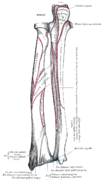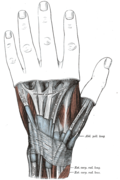| Extensor carpi ulnaris | |
|---|---|
 Posterior surface of the forearm. Extensor carpi ulnaris labeled in purple at center right. Posterior surface of the forearm. Extensor carpi ulnaris labeled in purple at center right. | |
| Details | |
| Origin | Humeral head: Lateral epicondyle of the humerus. (???-->)Ulnar head: Olecranon, posterior surface of ulna, antebrachial fascia |
| Insertion | 5th metacarpal |
| Artery | Ulnar artery |
| Nerve | Posterior interosseous nerve |
| Actions | Extends and adducts the wrist |
| Antagonist | Flexor carpi radialis |
| Identifiers | |
| Latin | musculus extensor carpi ulnaris |
| TA98 | A04.6.02.045 |
| TA2 | 2507 |
| FMA | 38506 |
| Anatomical terms of muscle[edit on Wikidata] | |
In human anatomy, the extensor carpi ulnaris is a skeletal muscle located on the ulnar side of the forearm. The extensor carpi ulnaris acts to extend and adduct at the carpus/wrist from anatomical position.
Being an extensor muscle, extensor carpi ulnaris is located on the posterior side of the forearm.
Origin and insertion
It originates from the lateral epicondyle of the humerus and the posterior border of the ulna, and crosses the forearm to the ulnar (medial) side to insert at the base of the 5th metacarpal.
Action
The extensor carpi ulnaris extends the wrist, but when acting alone inclines the hand toward the ulnar side; by its continued action it extends the elbow-joint.
The muscle is a minor extensor of the carpus in carnivores, but has become a flexor in ungulates. In this case it would be described as ulnaris lateralis.
Innervation
Despite its name, the extensor carpi ulnaris is innervated by the posterior interosseous nerve (C7 and C8), the continuation of the deep branch of the radial nerve. It would therefore be paralyzed in an injury to the posterior cord of the brachial plexus.
Injuries
A common injury to the extensor carpi ulnaris is tennis elbow. This injury occurs in people who participate in activities requiring repetitive arm, elbow, and wrist, especially when they are tightly gripping an object. Some symptoms of an extensor carpi ulnaris injury include pain when shaking hands or when squeezing/gripping an object. The pain worsens when a person moves their wrist with force. This pain intensifies because the extensor carpi ulnaris has an injury near the elbow area and as a person moves their arm, the muscle contracts, thus causing it to move over the medial epicondyle of the humerus. As a result, this causes irritation to the already existing injury. Some treatments for tennis elbow include occupational therapy, physical therapy, anti-inflammatory medication, and rest from the activity that caused the injury. A similar injury involving the medial elbow is known as golfer's elbow.
Treatment and diagnosis
An ECU injury most often requires imaging (CT, MRI, ultrasound) for diagnosis. After the ECU injury is diagnosed, a physician will choose a course of treatment, which depends upon the severity of the injury. Conservative treatments include immobilization and stabilization of the affected wrist by placing it in a cast. A long arm cast may be required in order to ensure that all wrist movement has been stopped. The duration of the immobilization is at the treating physician's discretion. After the immobilization period has ended, the cast will be removed and further analysis of the injury will be required. If the injury did not improve with the conservative courses of treatment, or if the injury was initially too severe for conservative treatment, invasive procedures may become necessary. Steroid injections and surgical procedures are the most prominent invasive procedures. Surgical repair or reconstruction of the ECU is not often required, yet a severe ECU injury may cause these approaches to be necessary.
Additional images
-
 Bones of left forearm. Posterior aspect.
Bones of left forearm. Posterior aspect.
-
 Bones of the left hand. Dorsal surface.
Bones of the left hand. Dorsal surface.
-
Cross-section through the middle of the forearm.
-
 Posterior surface of the forearm. Deep muscles.
Posterior surface of the forearm. Deep muscles.
-
 Transverse section across distal ends of radius and ulna.
Transverse section across distal ends of radius and ulna.
-
 Transverse section across the wrist and digits.
Transverse section across the wrist and digits.
-
 The mucous sheaths of the tendons on the back of the wrist.
The mucous sheaths of the tendons on the back of the wrist.
-
 Extensor carpi ulnaris muscle
Extensor carpi ulnaris muscle
-
Extensor carpi ulnaris muscle
-
Extensor carpi ulnaris muscle
References
- Clinically oriented anatomy. : Lippincott Williams & Wil. 2009. p. 751. ISBN 978-1-6083-1181-1.
- Chung, K (1995). BRS: Gross Anatomy.
- Moore, K; Agar, A (2002). Essential Clinical Anatomy (2nd ed.). Lippincott.
- Nirschl, RP (October 1992). "Elbow Tendinosis/tennis Elbow". Clin Sports Med. 11 (4): 851–70. doi:10.1016/S0278-5919(20)30489-0. PMID 1423702.
- Saladin, Kenneth S. Anatomy and Physiology: The Unity and Form of Function (5th ed.). ISBN 9780077396336.
- ^ Campbell, Doug; Campbell, Rob; O'Connor, Phil; Hawkes, Roger (4 October 2013). "Sports-Related Extensor Carpi Ulnaris Pathology: A Review of Functional Anatomy, Sports Injury and Management". British Journal of Sports Medicine. 47 (17): 1105–1111. doi:10.1136/bjsports-2013-092835. PMC 3812850. PMID 24096897.
- Patterson, Steve M.; Picconatto, William J.; Alexander, Julie A.; Johnson, Rachel L. (September–October 2011). "Conservative Treatment of an Acute Traumatic Extensor Carpi Ulnaris Tendon Sublaxation in a Collegiate Basketball Player: A Case Report". Journal of Athletic Training. 46 (5): 574–576. doi:10.4085/1062-6050-46.5.574. PMC 3418964. PMID 22488145.
External links
| Muscles of the arm | |||||||||||||||||
|---|---|---|---|---|---|---|---|---|---|---|---|---|---|---|---|---|---|
| Shoulder |
| ||||||||||||||||
| Arm (compartments) |
| ||||||||||||||||
| Forearm (compartments) |
| ||||||||||||||||
| Hand |
| ||||||||||||||||